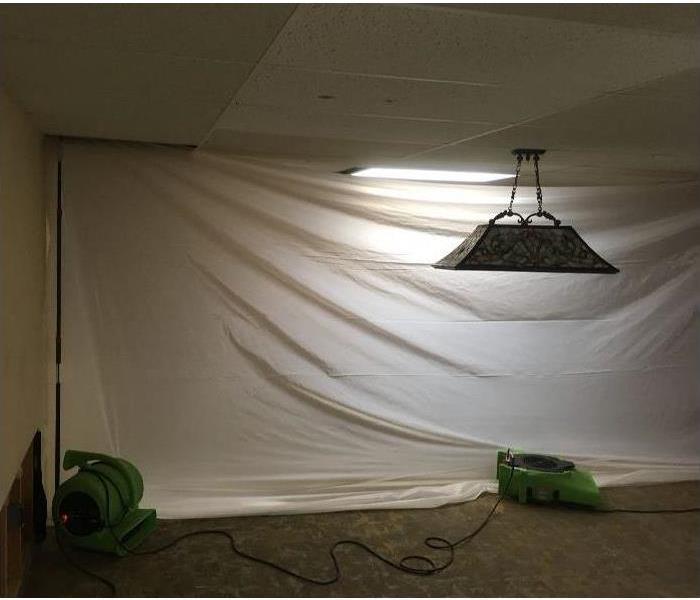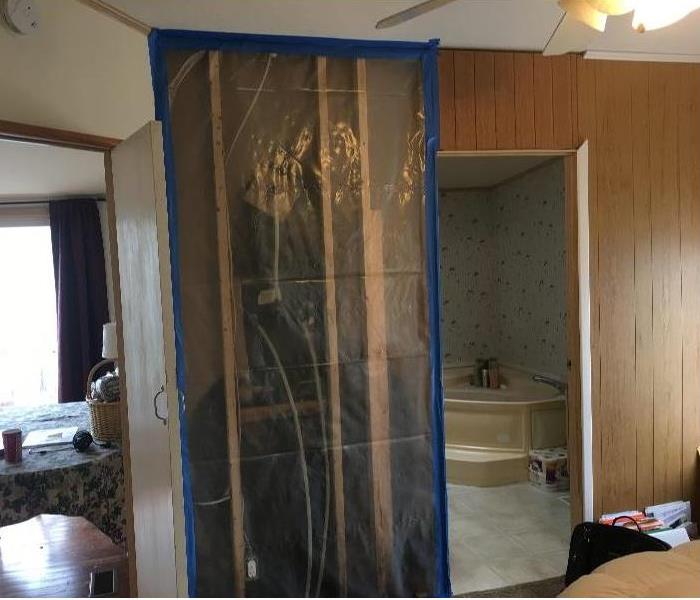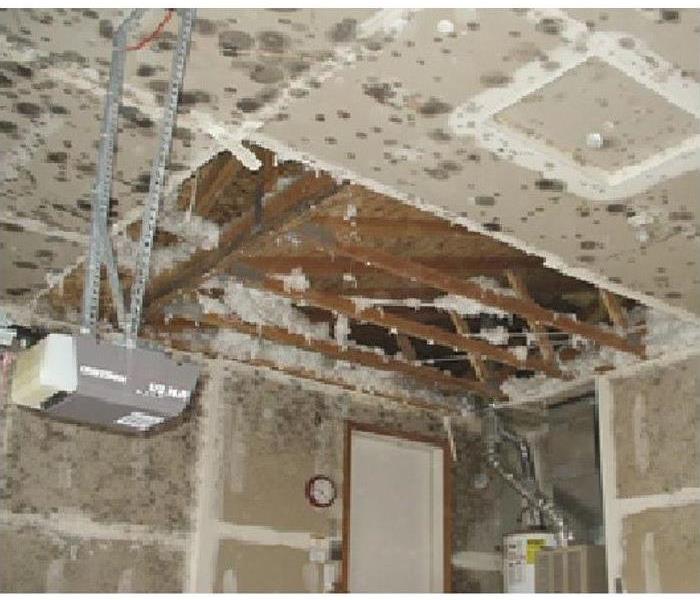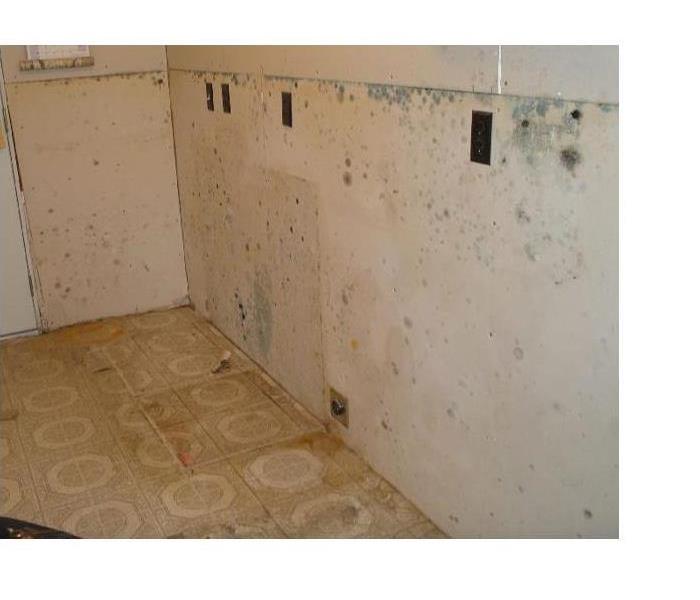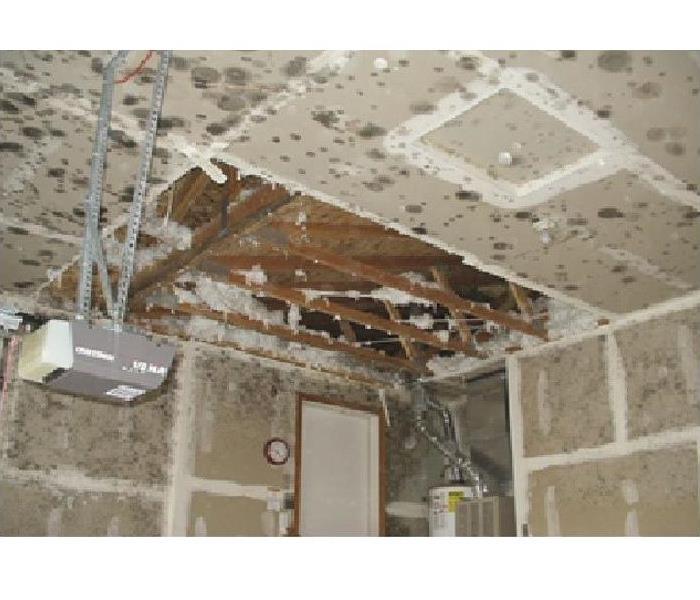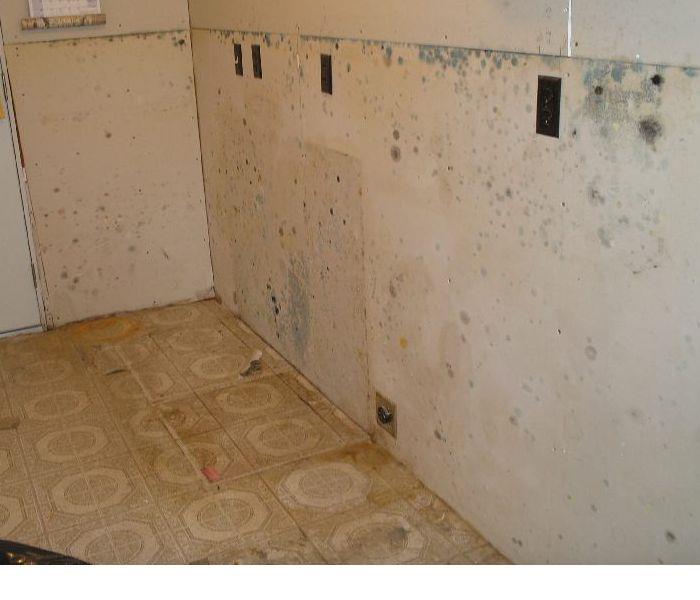Recent Mold Remediation Posts
Winter Water Damage Can Lead to Mold if You Don’t Act Appropriately
3/29/2023 (Permalink)
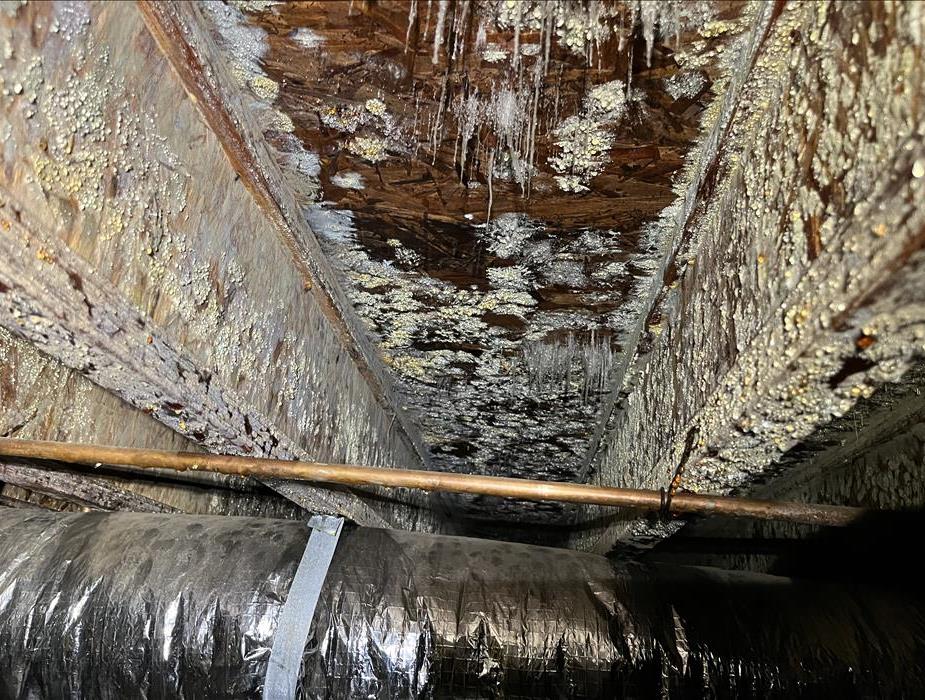 Water damage can lead to mold if not dealt with professionally
Water damage can lead to mold if not dealt with professionally
Winter Water Damage Can Lead to Mold if You Don’t Act Appropriately
Living in the High Desert of Central Oregon has its perks. We enjoy around 300 days of sunshine each year and direct access to world-class outdoor recreation. But we also have our fair share of severe storms with varying types of precipitation. Despite the storms and sometimes snowy winters, we have a very dry climate.
Now, when you think of mold, perhaps Florida or another tropical location comes to mind. But, many are surprised to learn that one of the most common calls we receive at SERVPRO of Bend is for mold remediation. We’ll explain why the High Desert is a hot spot for mold.
First, the basics. Mold is a microscopic spore that readily floats through the air. But mold isn’t a problem unless it has food. And mold food is moisture. As we mentioned, living in the High Desert has perks. And our dry climate means mold doesn’t have the food it needs to grow as readily as it does in more humid climates. Therefore, mold isn’t a big issue…until it is.
Water Damage and Mold - A Recipe for Disaster
With the freezing temperatures we’ve experienced this winter, there have been many frozen and subsequent burst pipes. The quick response to the average homeowner is to hire a plumber to address the burst pipe, mop up the water, and get on with the day. But, this is not usually the best course of action. Residual water that is not appropriately addressed becomes a breeding ground for mold spores - very quickly. Even our dry Central Oregon climate won’t dissuade hungry mold spores from tearing through your drywall.
So what’s hiding behind your walls?
Many homeowners with water damage won’t see mold as an issue until it has progressed and become a costly problem. You see, pipes that bust behind walls or in your crawlspace are hidden. Unless you tear out the walls (or go under your house), you won’t know a problem exists. And who wants to do that? You can wait and see if you notice the telltale scent of mold (it is musty). But even that is too late. So what should you do?
What to do in the event of water damage
- Act fast. Have a plumber fix the leak. Remove excess water by mopping it and then blotting it - including on furniture, carpets, upholstery, and cushions. Put aluminum foil between furniture legs and carpets. You can also prop up furniture with wood blocks. Move art, books, magazines, etc., out of the area.
- Get help. Don’t assume the water damage is resolved. A plumber will fix the source of the leak, but they aren’t going to address the damage done to your home. Remember, mold grows over time. If you do not address water hidden behind your walls, mold will take residence at an alarmingly fast pace. Hire a professional to inspect the area for water damage. We offer a basic inspection or a full inspection. The main difference are the tools we use for water detection.
- Don’t ignore old problems. If you had water damage in the past, you could still have an inspection to ensure mold isn’t growing anywhere in your home. Even if it is an old problem, mold will continue to grow until the source of moisture is addressed. Mold can be dangerous. Protect your family by ensuring it doesn’t have a chance in your home.
At SERVPRO of Bend, we have the tools, capability, and knowledge to identify and remediate water damage and mold issues so your home is safe and healthy for your family. If you have water damage or mold concerns, do not hesitate to contact our office for an inspection. We serve homes and commercial buildings throughout Central Oregon, including in North Deschutes, Crook, and Jefferson counties, and are available 24 hours a day, seven days a week. You can also request water damage repair and mold remediation by clicking the link here.
Mold Removal Isn’t the Same as Mold Remediation And Why You Should Care
10/13/2022 (Permalink)
You’ve got mold. You need to get it removed. Pretty straightforward, right? Or do you get it remediated? Is there a difference? Should you care?
Absolutely.
Before you grab some bleach and a sponge, there are some essential things you need to know that can impact not only your property but your health too.
Mold Removal Doesn’t Remove All Mold
Some restoration companies advertise “mold removal” and may even guarantee to remove all mold. This is a fallacy because removing all mold from a home or business is impossible. Microscopic mold spores exist almost everywhere, both indoors and outdoors. Mold spores float in the air and may enter your home or business through windows, doors, and AC/heating systems. They can even hitch a ride indoors on your clothing or family pet.
Mold spores thrive on moisture and can quickly grow into colonies when exposed to water. These colonies produce allergens and irritants and have the potential to cause other adverse health effects.
Because mold is everywhere, it is not possible to remove all of it. The best you can do is remove any visible mold. It is a temporary solution that will come back if not fully treated with a vengeance. And despite living in a dry climate, mold remediation in Bend is one of the most common services we provide both residentially and commercially.
Mold remediation, on the other hand, goes a considerable step further. The remediation process involves removing visible mold growth and then identifying the underlying cause of mold in your home or office. Remember, mold needs moisture to thrive. That means identifying the source of moisture is paramount to fixing the problem. Here’s how SERVPRO of Bend addresses mold remediation.
Mold Remediation in Bend, Oregon
- Mold Identification. Once you recognize a mold problem, contact someone to address it. At SERVPRO of Bend, we’re available 24-7 via our mold remediation emergency service. You can also request mold remediation help online by completing a form on our website. Either option will result in a SERVPRO of Bend team member asking for some details about your mold problem, so they can best serve you.
- Mold Inspection. As mentioned previously, to adequately address mold, it is critical that the underlying cause and the type of mold that is present be identified. Because it is sometimes difficult to detect the cause of mold, we use cutting-edge technology, including water meters and, when needed, an infrared-guided measurement. This technology allows us to find concealed moisture and provide a more accurate estimate of the extent of the damage.
- Mold Containment. Because mold can quickly spread to other areas of the home or office, it is vital for mold containment. This is also why it is important not to try to remove mold on your own. We use special equipment such as negative air chambers and physical barriers to prevent mold from spreading to other areas. HVAC units are also turned off during remediation to prevent mold from spreading through air ducts.
- Air Filtration. Another way we prevent the spread of mold is through the use of air filtration devices, which are air scrubbers and special HEPA filtration vacuums. These tools pull the microscopic spores from the air.
- Mold Removal. The next step to proper mold remediation is removing any contaminated materials depending on their porosity and susceptibility to damage. For example, drywall and carpet are both highly porous and susceptible to damage from mold. Because they are tough to clean thoroughly, they most often need to be replaced.
- Cleaning and Odor Removal. Mold typically has a musty odor. In fact, the odor may be how you first identified there was a mold problem. We thoroughly clean and treat any remaining elements that have been affected by mold to prevent future growth. This often includes flooring, furniture, curtains, and even important documents.
- Restoration. Every mold remediation job we do is different. Depending on the severity of the damage, our treatment process can vary. Any damaged items will be restored. This may involve minor repairs, such as replacing drywall and installing new carpet. We also offer documentation restoration, so your important documents aren’t lost forever. Our cutting-edge technology allows us to restore your paper goods to as close to their pre-damaged condition.
At SERVPRO of Bend, our tagline is “like it never even happened,” and we take it seriously. Mold only becomes a bigger problem with time. If you identify mold in your home or business, contact the mold remediation experts in Bend, Oregon. We offer both commercial mold remediation and residential services throughout Central Oregon and would be honored to help you.
Mold can be found in inconspicuous places
6/1/2022 (Permalink)
On several occasions, technicians from SERVPRO of Bend will be working at a property where water damage has occurred and find secondary damage such as mold.
The interesting factor is that some of that secondary damage wasn't a result of the current water loss. A house in Redmond, Oregon suffered a water loss and while removing some of the affected baseboard, they found mold that had grown between the wood base and the drywall. However, this particular area was not specifically affected by the current water loss.
Upon further investigation, the property owner communicated that they had a water loss the previous year but figured that they had cleaned it so quickly, that they didn't think it had affected any of the finishes in the home.
Even minor water losses, if not handled correctly can increase the opportunity for secondary damage, such as mold to occur.
If you have any questions about previous water damage, or current water damage that you feel might still be affecting your property, feel free to give SERVPRO of Bend a call at 541-385-7044.
Spring Mold: What’s Lurking Behind Your Walls?
5/26/2022 (Permalink)
We may live in the High Desert, but that doesn’t mean we are immune to mold. Mold is everywhere, and it has been around for millions of years. Mold has the important job of breaking down trees, leaves, and other plant matter.
Microscopic mold spores are floating through the air in search of food. They may enter your home or commercial space through windows, doors, AC/heating systems, or hitch a ride on your clothing or family dog. These airborne fungi love cellulose - or wood products. Mold can’t distinguish between the walls in our home and the dead tree in the forest. So if the environment is right, it will grow wherever it lands - and it eats what it lands on.
The springtime is the perfect time for the spores to visit. As the warmer weather beckons us to open our windows, mold can enter our homes. Plus, mold likes temperatures between 41 degrees to 100.4 degrees Fahrenheit. The only other thing mold needs to thrive is moisture. And while we tend to lack in the humidity department, any leaks or standing water will attract mold spores. Mold spreads very quickly, so even if you have a small mold problem today, it can become a significant problem before you know it.
How to Identify Mold
Mold has a telltale musty odor. It also can appear as spots of many different colors. Mold may appear on your walls, window sills, sink, or on your home's siding. But mold can also hide behind your walls, in your crawl space, or under your roof.
Act Fast.
If you find mold, it is essential to act quickly. As previously mentioned, mold virtually grows at warp speed. The sooner you respond, the more limited the damage - and the costs associated with repairing said damage.
Address the cause of the mold.
Mold and moisture go hand in hand. You must address the underlying cause, or the mold will return.
Don’t try to remove mold without containing the area.
Mold spreads by releasing millions of mold spores into the air. Only remove mold by containing the area and wearing personal protective equipment (PPE). Better yet, hire a mold remediation specialist like SERVPRO of Bend and SERVPRO of N. Deschutes, Crook, and Jefferson Counties.
Don’t cover up mold.
Never caulk or paint over mold. You can’t cover up the problem and hope it goes away. Ensure mold is properly removed and the underlying cause is fully addressed BEFORE painting or caulking the area.
Porous materials may need to be replaced.
Mold proliferates on porous surfaces, such as carpet, upholstery, and furniture. It will fill the empty spaces in the material (imagine a sponge with holes), making it virtually impossible to remove completely.
Understand the difference between removal and remediation.
Since mold spores are microscopic and exist everywhere, it is impossible to eradicate mold. To correctly address a mold problem, SERVPRO of Bend will:
- Inspect and assess the mold damage
- Contain mold using physical barriers and negative air pressure
- Filter the area to prevent the spread of spores during cleanup
- Remove mold and mold-infested materials
- Clean and disinfect all contents and belongings affected by mold
- Restore the areas impacted by mold
If you identify mold or suspect you may have a mold problem, call our experts today at 541-385-7044. We are here to answer your questions or concerns 24 hours a day and seven days a week.
Unfinished Crawlspace Can Cause Excessive Moisture
2/15/2022 (Permalink)
Many of the homes in Central Oregon are built with a crawlspace. A crawlspace is the narrow area between the ground and the first floor of a home. It is typically unfinished, with a dirt floor. In some cases it can be as narrow as 2-ft. x 2-ft., just enough room to crawl around inside — hence the name. A crawlspace is often an access point for electrical, plumbing and ventilation within the home.
A crawlspace is typically vented to the outside or an adjoining basement. This ventilation allows air to circulate below the house. However, if a crawlspace is not properly vented, excessive moisture from the ground can accumulate on wood and concrete. Many homeowners also like to use the space for storage, though one should consider the moisture and environment first. Unfinished, properly vented crawlspaces are good for storing construction materials like bricks, tiles, piping or anything that won’t be damaged by moisture. Ventilation is a key factor in optimizing a crawlspace.
Unless you live in a dry climate, moisture can be an issue, especially in an unfinished crawlspace. Not only would the humidity damage things like clothes, books, food and furniture, but moisture can lead to mold and mildew growth.
If you have questions about mold in a crawlspace or if your crawlspace is adequately ventilated, feel free to give SERVPRO of Bend a call at 541-385-7044. We service Bend, Redmond, La Pine, Prineville, Sunriver, Madras and most of Central Oregon.
Dry Rot in Central Oregon: Where, How & What to Do
6/28/2021 (Permalink)
More than 90 percent of all new homes are designed with wood serving as the primary material. Both natural and abundant, wood gives homes their shape while enhancing certain design elements that are pleasing to the eye.
Its most essential responsibility, however, is establishing a home’s structural integrity.
From beams, trusses, and joists to roofing, siding, and window frames, both builders and homeowners rely on wood to protect the longevity and safety of the structure while also protecting what, to most of us, is the most significant investment of our lives.
That’s why we at SERVPRO of Bend have determined that safeguarding a home from an all-to-common issue like dry rot is so critical.
If left undetected and untreated, dry rot can jeopardize a home’s structural integrity as well as its value. This can lead to safety issues, diminished home values, and thousands of dollars in future repair costs.
What is Dry Rot?
First off, the term “dry rot” is a bit of a misnomer.
Dry rot is a type of wood decay caused by a fungus called Serpula lacrymans. This type of fungus feeds on wood and timber, and for it to grow and spread, it needs a higher-than-normal level of moisture.
So, for dry rot to occur in a home, an excess moisture level must first exist. Unfortunately, there are plenty of ways for such levels of wetness to penetrate a home. These can include a leaky roof, undetected drippings from a pipe, or high moisture levels at or near the foundation of the house.
However, the moisture gets there, over time, it can permeate the wood that helps the fungus grow and breed. As it does, the fungus feeds on the wood, causing it to weaken and rot.
Despite this moisture-dependent structural breakdown, the affected wood can often feel dry and stiff to the touch.
To make matters worse, dry rot can spread through moisture-rich areas due to the release of airborne spores. So if your home’s crawl space is excessively humid, all the wood near your home’s foundation is at risk of dry rot.
This certainly isn’t a pleasant thought.
What Are the Signs of Dry Rot?
Unlike seemingly more extreme water damage caused by sudden pipe bursts, roof damage, or waterline leaks, dry rot often appears silently. But don’t let that fool you.
Under the right conditions, dry rot can spread quickly. It’s a fungi that is known to cause damage in areas of homes in, near, or around:
- Windows & Doors
- Basements & Crawl Spaces
- Wet Rooms (Bathrooms, Kitchen, Laundry Room, or any room with a plumbing fixture)
- Attics (Caused by roof damage or improper ventilation)
- Outdoor Siding & Decks
Regardless of where it occurs, the signs you may be dealing with (or soon will be dealing with) dry rot are relatively obvious. They include:
Wet or Moist Areas: Areas that are humid or improperly ventilated are prime spots for dry rot, whether that’s under your home or in the attic. Also, if you find leaks or condensation anywhere in your home – around windows, under sinks, near pipes, etc., you should also consider the possibility of dry rot.
Damp Smells: As a fungi, dry rot – as it grows and spreads – puts off a relatively distinct smell often described as damp, stale, or “mushroomy.” If you notice such smells in your home, be aware that dry rot (or, at the very least, water/moisture damage) may be the cause.
Swelling or Discoloration: If hidden around windowsills, in walls, along floorboards, etc., dry rot can cause areas of the interior to swell, discolor or become softer to the touch. Such signs can also show up outdoors, often near the bottom or along the seams of siding.
Wood Discoloration or Fungal Growth: An obvious sign to be sure, if you see this under a sink, in the attic, or under your home, you’re likely witnessing dry rot in action. In turn, this should cause you to spring into action.
What Do I Do?
If you suspect dry rot is eating away at the wood in, under, over, or around your house, don’t assume the damage is already done. You must limit the damage before it spreads any further.
This includes, of course, determining the source of your home’s excess moisture and correcting it, so your dry rot issue doesn’t return.
At SERVPRO of Bend, our mold removal team is trained and highly experienced in dry rot and mold remediation, applied microbial remediation, water damage restoration, and applied structural drying.
After taking care of your source of water or excess moisture, our team will:
- Inspect and assess the damage
- Contain the area using a negative air pressure system
- Filter the air in the infected areas
- Remove the fungi materials
- Clean and restore the area and its contents
We provide these as both scheduled and emergency services. And, if you require these services as part of an insurance claim, know that while it’s OK for an insurance company to suggest a service provider, it’s your right to choose the mold remediation service provider you desire.
To learn more or schedule your initial mold assessment, call us at (541) 385-7044.
Does My Home Have a Mold Problem? It Can Happen, Even in Central Oregon
6/2/2021 (Permalink)
Central Oregon markets the region as a vacation destination, one that distinguishes itself from other, more lush parts of the state thanks to its drier, sunnier high-desert climate.
Yet, we at SERVPRO of Bend would like to warn local homeowners not to become complacent due to the relative dryness of this area, especially where water damage and mold are concerned.
While mold can be a more troubling issue for those living in the valley and in the coastal regions of Oregon, it also still exists in Central Oregon.
Mold, after all, is everywhere. It exists as microscopic spores that flow through the air around us, both indoors and out. And, under the right conditions, mold spores can settle, colonize, thrive, and produce odors, allergens and irritants.
Where Does Mold Grow?
Homeowners who identify mold in their homes commonly find it growing in drywall and walls, in attics and crawl spaces, under leaky sinks, in showers, in ductwork … anywhere you may find a combination of moisture, cool temperatures and relative darkness.
A type of airborne fungus, mold can germinate in as few as 12 hours and start reproducing within one to two days. This process involves continually shooting microscopic spores into the air.
Mold can also produce an objectionable odor that can best be described as “musty.” In addition, it will typically damage surfaces on which it grows, whether that’s wood, drywall, grout or fabric.
What Are the Signs I Have Mold in My House?
If you know what you’re looking for or where to look, the most obvious sign you have mold in your home is that you simply see it. If you open a bathroom cupboard or duck down into your home's crawl space, for instance, mold will often stand out as dark spots in or around moist or humid environments.
If you’re not out looking for it, however, some of the top signs you may have a mold problem in your home include:
A Musty Odor: You may not notice this all throughout the home, but if you start to recognize a musty odor under sinks, in the shower, around duct vents, behind appliances, in the attic, etc., it may be time to start inspecting for mold.
Water Leaks/Damage: If you find water leaks that appear to have gone unnoticed for a period of time or uncover signs of water damage in your home, these are prime spots for mold. Thoroughly check these area(s) for growth.
Warping, Cracking or Peeling: Moisture that seeps into your drywall will nearly always result in the growth of mold. So, if you notice any bubbling, peels or cracks in your drywall that may indicate excess moisture, you’re likely to also have a mold problem.
What If I Find a Mold Issue?
The first thing to know is that mold spreads quickly, so even if you have a small mold problem today, it can become a major problem before you know it. So, don’t drag your feet. The quicker your response to a mold problem, the more limited the damage (and the costs of the damage) will be.
Secondly, wherever one might find mold in their homes, the one common denominator is moisture. To therefore remediate a home’s mold issue, one must also quickly address the causes and sources of said moisture, otherwise the mold is bound to come right back.
Here at SERVPRO of Bend, we are highly trained mold remediation specialists with advanced education in applied microbial remediation, water damage restoration, and applied structural drying.
After cutting off the source of water, moisture and/or humidity, our team will:
- Inspect and assess the mold damage
- Contain the area using a negative air pressure system
- Filter the air in the infected areas
- Remove the mold and any mold-infested materials
- Clean and restore the area and its contents
We provide these as both scheduled and emergency services. And, if you require these services as part of an insurance claim, know that while it’s OK for an insurance company to suggest a service provider, it’s your right to choose the mold remediation service provider you desire.
To learn more or to schedule your initial mold assessment, call us at (541) 385-7044.
Mold: the Basic Facts
2/19/2021 (Permalink)
Mold is very common in both commercial and residential properties. You might not like hearing that, but it's true. Even if you can't see or smell it, the likelihood of there being some mold in your attic, basement, HVAC system or bathroom is relatively high. But don't panic: in most cases mold is not a hazard to your health or the building. Though that being said, it is always something to be aware of.
So how does mold enter your home or business? Mold can enter structures through doorways, windows, ventilation systems and any other open airways with ease. Likewise, mold spores can also attach themselves to your shoes or clothing, waiting for a nice damp spot where they can grow. Unfortunately for home owners, there are many materials that are perfect for this growth; cellulose materials like wallpaper and cardboard, ceiling tiles, wood paneling, and even carpets, drywall and upholstery can easily become slightly damp and begin to support a rapid spread of mold.
Now that you know a little bit about mold and how it spreads, what can you do to stop it? Luckily, there are some simple things to take notice of: controlling the humidity, promptly fixing any leaks from the ceiling, windows or pipes, thoroughly cleaning and drying after water spills, and properly ventilating bathrooms, kitchens and laundry rooms are all easy ways to keep mold growth from starting. Also, in many cases, you may be able to catch a small patch of mold before it gets too large and even treat it yourself without having to hire a mold mitigation company who at that point would likely have to take more invasive measures.
If you have a mold problem that has gotten out of hand, or are worried you may have mold but aren't sure, please contact SERVPRO of Bend today for a consultation!
Mold Staining
3/7/2019 (Permalink)
It isn't uncommon in Central Oregon to find that a lot of homes suffer from poor ventilation in the attic space, that can result in secondary damage, such as microbial growth or staining from microbial growth.
SERVPRO of Bend was called out to this residential property in Redmond, OR when the owner noticed that one side of their home had clear plywood on the inside of the roof material but the north facing side of the interior plywood was covered in black.
SERVPRO of Bend technicians went into the attic and metered the north side of the roof material and found that it was not metering wet. However, the attic space was stuffy, and it felt as if there was not adequate ventilation.
After calling a roofer, the homeowner realized that the attic needed more vents. Once the roofer completed the installation of new vents, SERVPRO of Bend was called back to remove the staining.
After spraying the affected area, the result was a clean, almost new looking plywood on the north facing side of attic interior.
Mold Found Beneath Game Room Floor in Tumalo, Oregon Game Room
1/2/2019 (Permalink)
This older home in Tumalo, Oregon had a water loss so SERVPRO of Bend was called out to assess the damage. An ice maker in the game room had leaked, causing some damage to the flooring material.
Upon removing some of the flooring material, SERVPRO of Bend's water technicians found that there was some mold growth beneath the floor, likely caused by a previous loss. Upon approval for the insurance carrier, the team build a containment and was able to remove the affected material.
After the affected material was removed, the water technicians were able to dry the affected subfloor material.
Mold Found in Wall Cavity, La Pine Oregon
11/13/2018 (Permalink)
This newer house in La Pine, Oregon had a leak in a half-bath that was above this hallway. The homeowner called SERVPRO of Bend because the began smelling a musty odor.
SERVPRO of Bend's Certified Mold Specialist went out to the residence to investigate. After using surface moisture meter and infrared camera, the technician found that the inside of the wall had been damaged by water.
SERVPRO of Bend's water team went into action. Upon removing the damaged drywall, they found existing microbial growth. The crew took the necessary precautions and remediated the mold.
After removing the mold, the team sprayed the area with an anti-microbial and covered the affected area with plastic sheeting to encapsulate the area for better containment. Once the area was dry, the structural team was able to put back the new materials back to its preloss condition.
Mold Found During a Routine Inspection
8/3/2018 (Permalink)
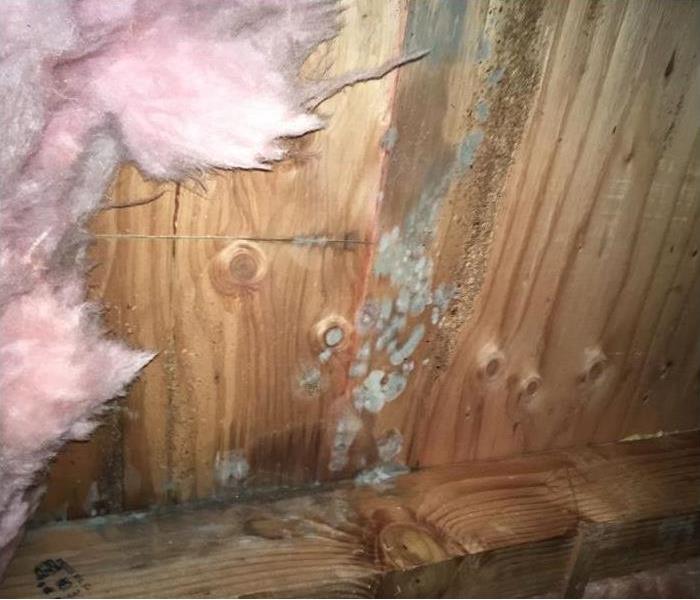 Crawlspace Mold
Crawlspace Mold
SERVPRO of Bend was called out to a customer after they were worried about ground water seeping into their crawlspace.
The homeowner noticed water settling beneath their vapor barrier. The vapor barrier looked to them to be full of air and when they poked it, water came seeping through.
SERVPRO of Bend certified WRT technicians put on their personal protective equipment and went into the crawlspace to investigate. They found that the sump pump had malfunctioned, causing the water to collect beneath the house.
Technicians inspected other areas of the crawlspace an found that just above the are where the standing water was, mold was starting to grow. After fixing the sump pump, SERVPRO of Bend was able to safely remove the mold from the crawlspace area.
Biology of Mold
8/2/2018 (Permalink)
SERVPRO of Bend receives many calls from concerned customers regarding mold. Here is some information that may help understand the Biology of Mold.
Mold is a fungus
Number of species of mold is not known, however
- At least 20,000, but may be as many as 300,000 different species of mold
- Mold derives its nutrients from decomposing, organic matter.
We have seen many places where mold has begun to grow. Here are a few of those materials: Paper, Wood, Drywall and Paint to name a few.
Mold loves water and damp areas, especially in areas where the relative humidity is greater than 60%.
SERVPRO of Bend is committed to being on site to any size disaster, especially water in 4 hours so we can limit the amount of secondary damages like mold.
If you have any questions about Mold or any other Damage to your property, give us a call
541-385-7044
Bathroom Hazards, Like Mold To Be Aware Of
3/6/2018 (Permalink)
MoldWith a daily influx of humidity, bathrooms are a prime locale for mold. You can often see it in the grout between tiles or along caulk lines, but it can also grow out-of-sight behind walls and ceilings, under floors, or inside ductwork. Prevent the buildup with proper ventilation, including dehumidifiers, fans, and open windows.
Soap ScumNeglecting the tub isn’t just unsightly—that slimy buildup can lead to slips and falls while bathing or getting in and out of the tub. The bathroom is the leading location for unintentional injuries, especially for older people, so in addition to keeping the tub or shower floor clean, consider adding non-slip strips to the floor or installing grab bars to decrease the risk of injury.
Air FreshenersEveryone knows what happens in the bathroom—but covering up the scent with an air freshener may do more harm than good. Some sprays contain VOCs and cancer-causing chemicals such as benzene and formaldehyde. If it stinks, open a window or turn on a fan.
Flexible Vinyl FlooringSure, it’s a quick upgrade, but some vinyl flooring contains phthalates, a volatile compound often used to make plastics more flexible and durable. This chemical releases into the air and household dust, especially in enclosed areas, and high levels of phthalates have been linked to asthma and allergies in children.
Bathroom CleanersIt’s tempting to use the super-duper strongest cleanser you can find, but some commercial cleaners contain chemicals that can irritate the eyes and skin or emit dangerous fumes. Instead, look for cleansers certified as the Safer Choice by the EPA, or make your own from non-toxic products like vinegar, borax, and baking soda.
If you have questions or need help cleaning up a mess, feel free to call SERVPRO of Bend's Cleaning Team at 541-385-7044
Basement Mold
1/2/2018 (Permalink)
If your house has a basement, then basement water leakage and excess basement humidity levels could be one of the contributors to mold growth in your home. It has been documented that at least "98% of all sub-surface basement areas will leak, at some point in their life."
There can be many reasons for a damp or leaky basement and they all add up to problems for as homeowners, if not corrected. Actual water leakage should not be confused with the high relative humidity typically found in basements. Both can pose serious problems, but need very different approaches to affect a cure.
Moisture trapped between the foundation wall and the finished basement wall can allow mold to grow unnoticed. Long-standing moisture problems can lead to decay, resulting in structural damage to the house.
If you have questions about a high amount of humidity in your home or feel that you have some sort of abnormal growth on building materials, you can call SERVPRO of Bend and we would be glad to help.
SERVPRO of Bend
541-385-7044
Mold: Causes and Growing Conditions
8/7/2017 (Permalink)
Molds are found everywhere, and can grow on almost any substance when moisture is present. They reproduce by spores, which are carried by air currents. When spores land on a moist surface suitable for life, they begin to grow. Mold is normally found indoors at levels which do not affect most healthy individuals.
Because common building materials are capable of sustaining mold growth and mold spores are ubiquitous, mold growth in an indoor environment is typically related to water or moisture and may be caused by incomplete drying of flooring materials (such as concrete). Flooding, leaky roofs, building-maintenance or indoor-plumbing problems can lead to interior mold growth. Water vapor commonly condenses on surfaces cooler than the moisture-laden air, enabling mold to flourish. This moisture vapor passes through walls and ceilings, typically condensing during the winter in climates with a long heating season. Floors over crawl spaces and basements, without vapor barriers or with dirt floors, are mold-prone. Some materials, such a polished concrete, do not support mold growth.
If you have questions about Mold or any other possible hazard in your home, feel free to call SERVPRO of Bend at 541-385-7044.
How SERVPRO of Bend Assesses Mold
8/7/2017 (Permalink)
The first step we do in assessing mold is to non-intrusively determine if mold is present by visually examining the premises; visible mold helps determine the level of remediation necessary. If mold is actively growing and visibly confirmed, sampling for its specific species is usually unnecessary.
Intrusive observation is sometimes needed to assess the mold level. This includes moving furniture, lifting (or removing) carpets, checking behind wallpaper or paneling, checking ventilation ductwork and exposing wall cavities. Detailed visual inspection and the recognition of moldy odors are used to find problems. SERVPRO of Bend focuses on areas where there are signs of liquid moisture or water vapor (humidity), or where moisture problems are suspected.
If you suspect mold in any structure, call a firm that is certified in Mold Identification and Remediation, such as SERVPRO of Bend.
Types Mold Sampling
8/7/2017 (Permalink)
Types of samples include air, surface, bulk, and swab. Air is the most common form of sampling to assess mold levels. Indoor and outdoor air are sampled, and their mold-spore levels compared.
Air sampling often identifies hidden mold. Surface sampling measures the number of mold spores deposited on indoor surfaces, collected on tape or in dust.
Bulk removal of material from the contaminated area is used to identify and quantify the mold in the sample. With swab, a cotton swab is rubbed across the area being sampled, often a measured area, and subsequently sent to the mold testing laboratory. Final results indicate mold levels and species located in suspect area.
Multiple types of sampling are recommended by the American Industrial Hygiene Association (AIHA), since each has limitations; for example, air samples will not identify a hidden mold source and a tape sample cannot determine the level of contamination in the air. If you need to take air samples of a structure that may have mold, SERVPRO of Bend recommends calling a certified Industrial Hygienist before performing any work on the dwelling.
If you have any questions, you can talk to one of our AMRT certified technicians at 541-385-7044.
Fungal Growth Phases
8/7/2017 (Permalink)
From the time a spore or a hyphal fragment germinates to form a colony to the time the fungus dies, there are a number of growth phases. Although these phases have been determined under laboratory conditions, it is possible that the same occur in nature. In nature the duration of each phase would be determined by the environmental conditions including other competing micro-organisms.
- Lag phase
Once the growth conditions become favorable for the fungal propagules (i.e., viable spores or mycelial fragments) to germinate, new transport systems must be induced before growth commences. Thus growth starts slowly and accelerates gradually. This phase is referred to as the lag phase. - Exponential or log phase
Exponential growth occurs only for a brief period as hyphae branches are initiated, and then the new hypha extends at a linear rate into in-colonized regions of substrate. The biomass of the growing fungus doubles per unit time. As long as the nutrients are in excess growth remains constant during the exponential phase. - Stationary phase
As soon as the nutrients are depleted or toxic metabolites are produced growth slows down or is completely stopped. The biomass increases gradually or remains constant. During the stationary phase, hyphal growth stops and, in some molds, cell differentiation occurs, resulting in spore formation. During this process nutrients are transferred from the vegetative mycelium to the developing spores. The spores are dispersed by air movement to other areas of the building where they can start new mold growth once the conditions for growth are favorable. - The death phase
During the death phase, the mycelium eventually dies off. The death phase is usually accompanied by breakdown of the mycelia through self-digestion. Some fungi form spores by fragmentation of the hyphae
Molds in the Environment - Part 2
7/28/2016 (Permalink)
What areas have high mold exposures?
Antique shops
Greenhouses
Saunas
Farms
Mills
Construction areas
Flower shops
Summer cottages
I found mold growing in my home, how do I test the mold?
Generally, it is not necessary to identify the species of mold growing in a residence, and CDC does not recommend routine sampling for molds. Reliable sampling for mold can be expensive, and standards for judging what is and what is not an acceptable or tolerable quantity of mold have not been established.
A qualified environmental lab took samples of the mold in my home and gave me the results.
Standards for judging what is an acceptable, tolerable, or normal quantity of mold have not been established. If you do decide to pay for environmental sampling for molds, before the work starts, you should ask the consultants who will do the work to establish criteria for interpreting the test results. They should tell you in advance what they will do or what recommendations they will make based on the sampling results. The results of samples taken in your unique situation cannot be interpreted without physical inspection of the contaminated area or without considering the building’s characteristics and the factors that led to the present condition.
If you have any questions about mold, SERVPRO of Bend is here to help. You can talk to one of our certified technicians to better assess your situation.
Molds in the Environment - Part 1
7/26/2016 (Permalink)
Molds in the Environment
What are molds?
Molds are fungi that can be found both indoors and outdoors. No one knows how many species of fungi exist but estimates range from tens of thousands to perhaps three hundred thousand or more. Molds grow best in warm, damp, and humid conditions, and spread and reproduce by making spores. Mold spores can survive harsh environmental conditions, such as dry conditions, that do not support normal mold growth
What are some of the common indoor molds?
- Cladosporium
- Penicillium
- Alternaria
- Aspergillus
Where are molds found?
Molds are found in virtually every environment and can be detected, both indoors and outdoors, year round. Mold growth is encouraged by warm and humid conditions. Outdoors they can be found in shady, damp areas or places where leaves or other vegetation is decomposing. Indoors they can be found where humidity levels are high, such as basements or showers
How can people decrease mold exposure?
Sensitive individuals should avoid areas that are likely to have mold, such as compost piles, cut grass, and wooded areas. Inside homes, mold growth can be slowed by controlling humidity levels and ventilating showers and cooking areas. If there is mold growth in your home, you should clean up the mold and fix the water problem. Mold growth can be removed from hard surfaces with commercial products, soap and water, or a bleach solution of no more than 1 cup of household laundry bleach in 1 gallon of water.
If you choose to use bleach to clean up mold:
- Never mix bleach with ammonia or other household cleaners. Mixing bleach with ammonia or other cleaning products will produce dangerous, toxic fumes.
- Open windows and doors to provide fresh air.
- Wear non-porous gloves and protective eye wear.
- If the area to be cleaned is more than 10 square feet, consult the U.S. Environmental Protection Agency (EPA) guide titled Mold Remediation in Schools and Commercial Buildings. Although focused on schools and commercial buildings, this document also applies to other building types.
- Always follow the manufacturer’s instructions when using bleach or any other cleaning product.
Specific Recommendations:
- Keep humidity levels as low as you can—no higher than 50%--all day long. An air conditioner or dehumidifier will help you keep the level low. Bear in mind that humidity levels change over the course of a day with changes in the moisture in the air and the air temperature, so you will need to check the humidity levels more than once a day.
- Use an air conditioner or a dehumidifier during humid months.
- Be sure the home has adequate ventilation, including exhaust fans.
- Add mold inhibitors to paints before application.
- Clean bathrooms with mold killing products.
- Do not carpet bathrooms and basements.
- Remove or replace previously soaked carpets and upholstery.
10 Unexpected Places Where Mold Creeps Into Your Home
6/22/2016 (Permalink)
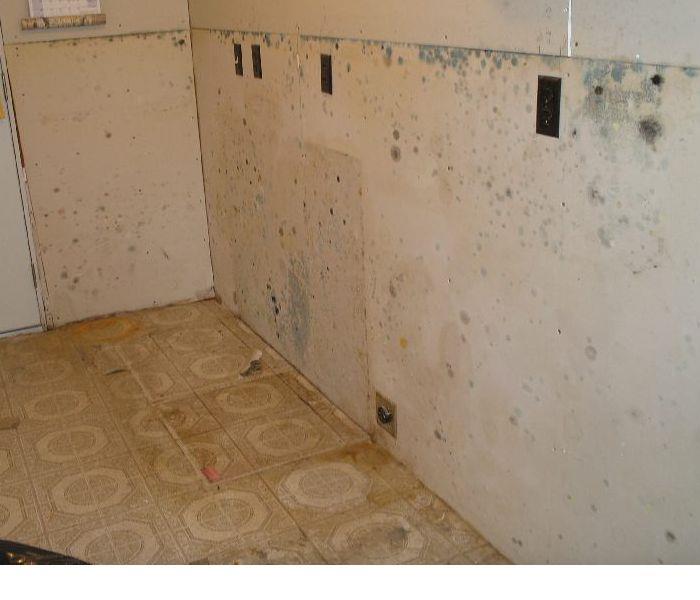 Mold Behind Cabinetry
Mold Behind Cabinetry
The Smith’s didn’t notice the mold and mildew smell in their home until they came home from vacation.
“What’s that smell?” John asked.
“Mildew. Maybe mold. Maybe I left some clothes in the washer,” Kathy said.
After an hour-long search, the couple couldn’t find a leak. So they called John’s brother David — a plumber. He came right over.
“The number one rule for checking for mold and mildew?” David said, “If it uses water, chances are it’s going to leak.”
These are 10 places many homeowners overlook when checking for mold:
1. DISHWASHER
2. ICE MAKER CONNECTIONS
3. WASHING MACHINE CONNECTIONS
4. HOT WATER HEATER
5. PLASTIC P-TRAP
6. TOILET CONNECTIONS
7. SHOWER DOORS
8. BATHTUB
9. EXTERIOR HOSE BIB
10. OUTDOOR WATER SPRINKLERS
As a homeowner, if you take the appropriate precautions and are vigilant about upkeep, you should be able to avoid mold, or catch it at it’s outset. While mold can be a huge problem in homes, even causing health issues, it is easily preventable
Got Mold? Here Are Some Things To Know
6/22/2016 (Permalink)
Just the idea of mold can cause panic for a homeowner. It can create structural issues and seriously affect your property value. But how do you even know if you have mold and how should you proceed if you do?
What causes mold?
“Mold is a fungus that’s an integral part of the earth’s bio-mass,” Cascone says. It consumes and breaks down organic material, like leaves, wood, and plants. “The problem,” he says, “is when mold colonizes in our buildings, consumes our building materials, and puts spores into our indoor air.” This happens when there’s a moisture problem since mold can’t grow without water. “When there’s enough moisture or humidity for colonization, that’s when humans begin to have problems.”
What are the most common causes of mold in homes?
The unfortunate reality is that problematic mold can really pop up anywhere that isn’t dry. Cascone says it sees it most often in attics due to roof leaks, poor air circulation, and bathrooms that ventilate into the attic rather than outdoors; crawl spaces because earthen or gravel flooring allows moisture and spores to rise from the soil; basements that have flooding from foundation leaks or plumbing leaks; and interior living spaces with leaks, bad windows, and high humidity.
Is there a chance I have mold and don’t even know it?
Cascone says there are four criteria that you should be aware of:
- A musty odor is caused during the colonization of some fungal species, but can come and go depending on moisture levels and air current changes.
- If you have water staining or if building materials have discoloration that’s spreading over time… that may be a sign of mold.
- Mold spores that were already present will begin to colonize just 48 hours after a water event.
What is the removal process like?
The remediation process (providing a remedy to a known mold issue) involves three things, Cascone says. Killing the fungi, removing the dead mold, and protecting against future mold growth/colonization. In order to do this, Cascone has a multi-step process that he uses:
- Contain work area and apply negative air pressure HEPA air purifiers to prevent cross-contamination.
- Mist EPA registered anti-microbial to suspend and kill mold spores.
- Remove affected building surfaces.
- Bag and dispose properly
- Treat cavities/underlayment and dehumidify.
- Abrasively remove dead loose mold.
- Apply EPA registered protective sealer.
- Perform clearance testing.
- Remove containment materials.
Why is it important to hire a professional?
Cascone says, “It is always a good idea to consult with an honest mold professional.” If there’s an issue you can tackle yourself, they should give you recommendations about how to do so. “Honestly though,” he says, “it may be a bit too much for a homeowner to keep safe while preventing cross contamination, killing mold, removing it and preventing new mold from growing.” That’s when a professional is necessary, so you can get things done properly.
At SERVPRO of Bend, we are certified in Applied Microbial Remediation through the IICRC.
What are the costs typically associated with mold removal?
“Remediation in attics and crawl spaces run about $2 per square foot of surfaces treated,” Cascone says. “When treating attics and crawls, it is important to treat ALL decking, joists and attic trusses. As for remediation that involves demolition of drywall, paneling, flooring, ceiling tile, cabinets, disposal containers, cleaning and sanitizing HVAC ducts, etc., it may be $4 to $6 per square foot.”
Toxic mold shuts down Oregon City fire station
5/12/2016 (Permalink)
OREGON CITY, Ore. (AP) — A Clackamas County fire station has closed down after toxic mold was found inside the facility, forcing firefighters to temporarily relocate.
KPTV-TV reports (http://bit.ly/1NlnprV ) that fire spokesman Steve Hoffeditz says medical response time for residents in Oregon City’s Hilltop District 16 should not be affected by the closure. The station’s five firefighters are being moved to another station in Oregon City a few miles away.
Fire Captain Andy Welks says the mold was discovered after he and some of his crew had been experiencing allergy-like symptoms and noticed a bad odor in the building.
Officials expect the Hilltop station to remain closed for at least another month while it undergoes inspection and the mold is removed

 24/7 Emergency Service
24/7 Emergency Service

